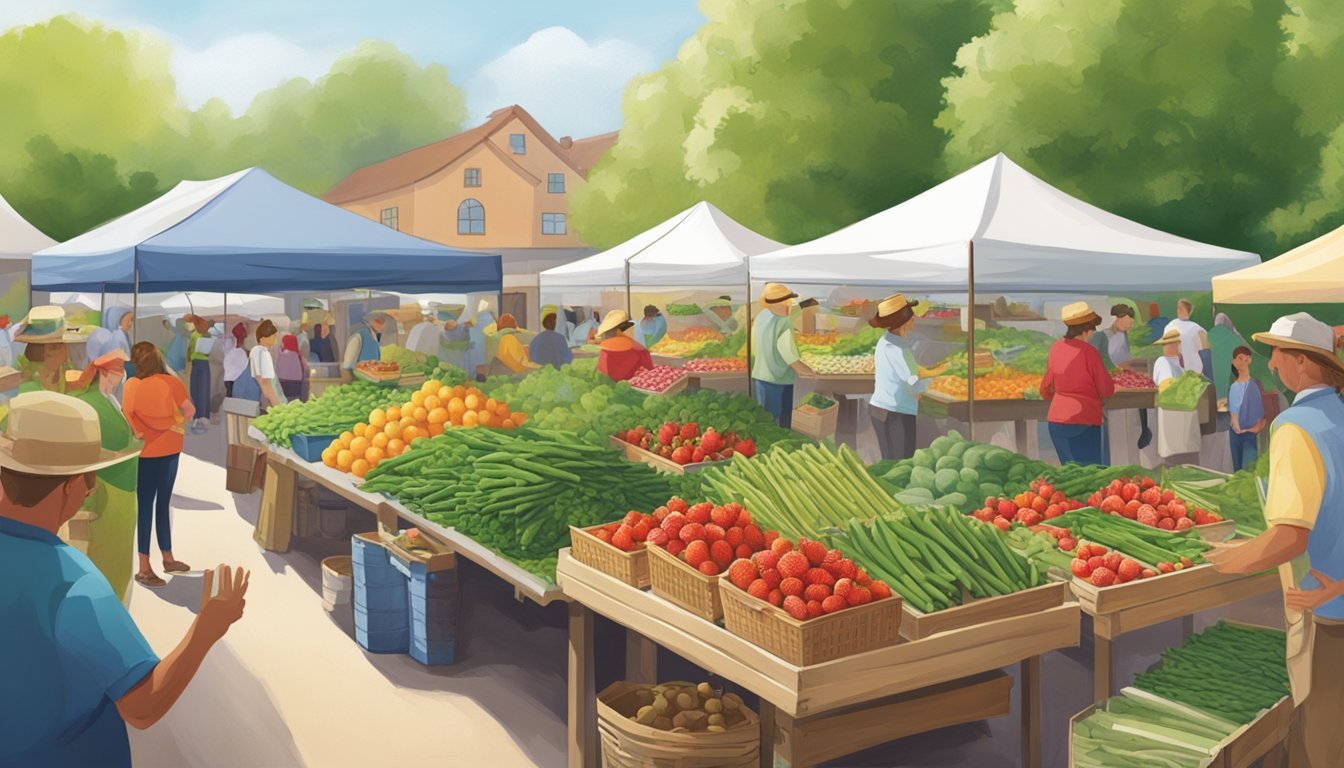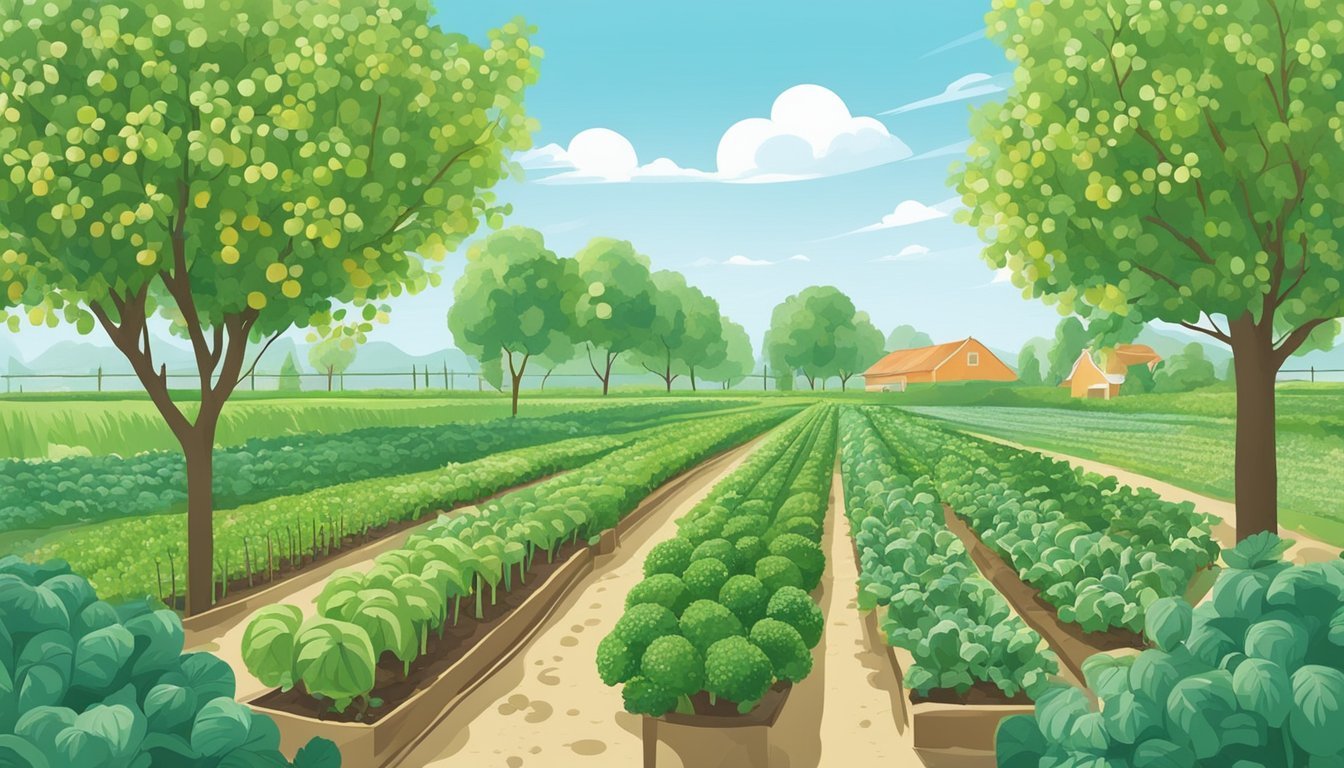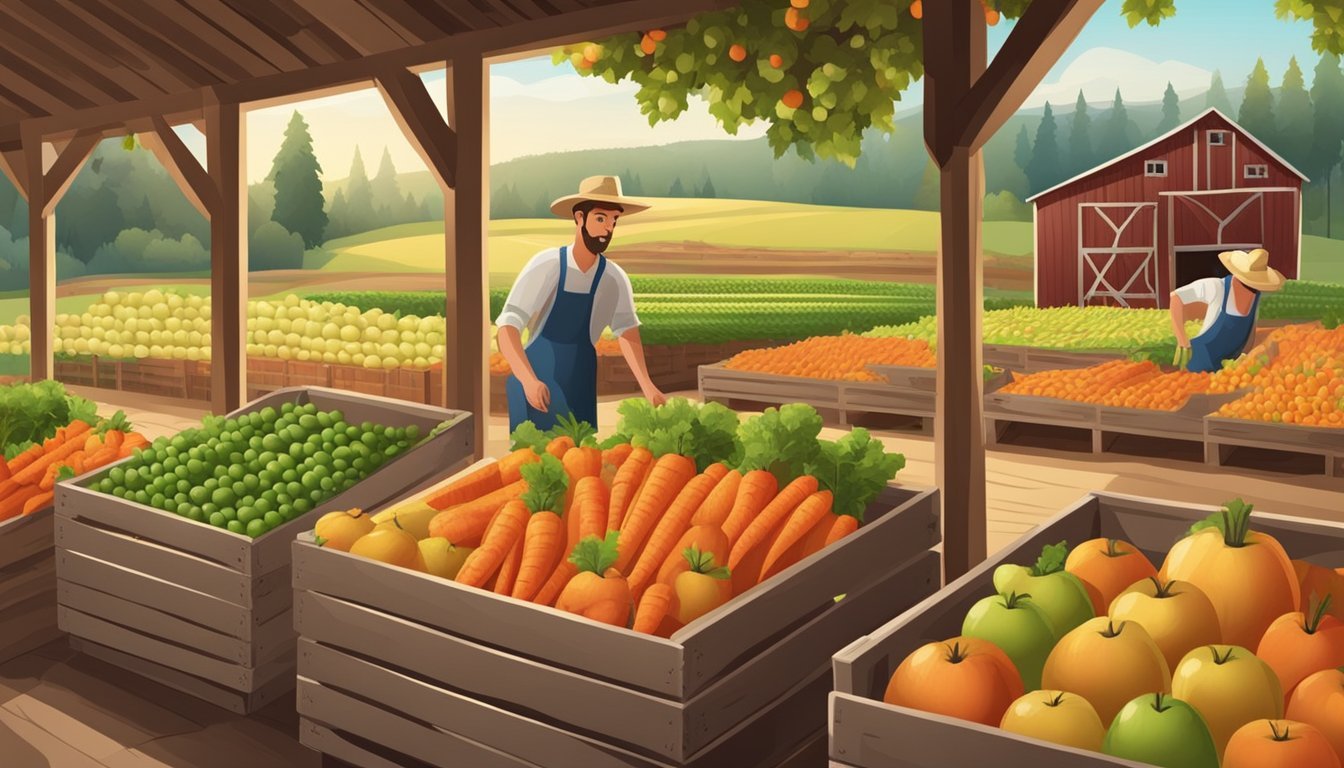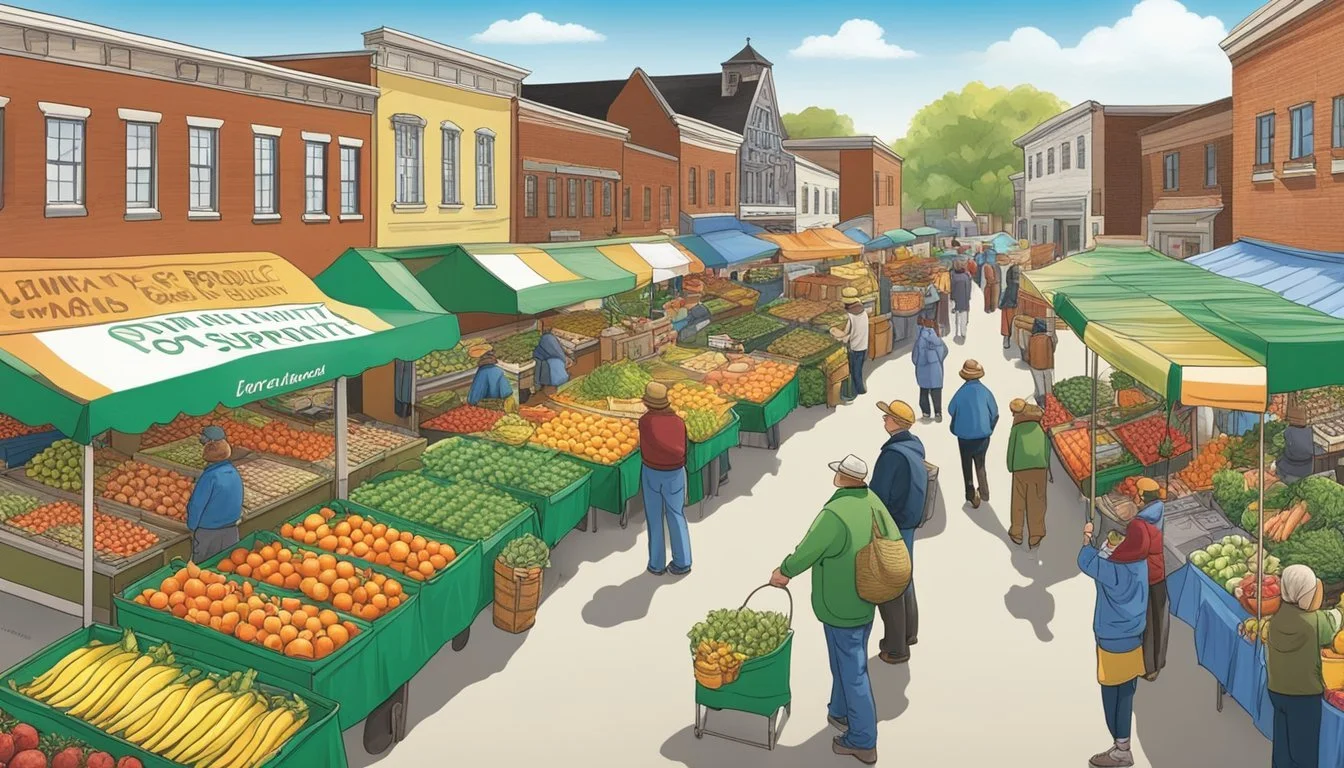Indiana Seasonal Fruit & Vegetables in March
Your Guide to Fresh Produce
This Article is Part of our Indiana Seasonal Fruit & Veg Calendar
As March ushers in the early signs of spring in Indiana, the state's assortment of seasonal fruits and vegetables begins to shift. Indiana's climate, characterized by its hard frosts and hot summers, contributes to a distinct cycle of produce availability. During this month, residents and chefs alike look forward to incorporating a variety of fresh, local produce into their culinary creations, tapping into the freshness that comes with the end of the winter season.
The rhythm of the seasons is evident in Indiana's agricultural output, and March provides a unique mix of the last of winter's offerings and the first tender arrivals of spring. While the selection might not be as abundant as the peak summer months, there are still ample opportunities for those seeking farm-fresh, nutrient-rich produce. The region's growers supply an array of vegetables that tolerate the cool, transitional weather, ensuring that local markets are stocked with a selection appropriate for the time of year.
Navigating the seasonal produce in Indiana is simplified with a general understanding of what is typically harvested during this period. Root vegetables and hearty greens often withstand the chilly early spring temperatures, while certain fruits and more delicate vegetables await warmer days. Those committed to eating seasonally can take advantage of the available selection, enjoying the flavors that are at their peak during the early spring, and anticipating the bounty that warmer weather will soon bring.
Seasonality and Plant Hardiness Zone in Indiana
In Indiana, the planting and growth of fruits and vegetables are significantly influenced by the local plant hardiness zones and the seasonal weather patterns, especially in March, when the state transitions from winter to spring.
Understanding Plant Hardiness Zone
Indiana spans several USDA Plant Hardiness Zones, ranging primarily from 5b to 6b. This classification signifies the temperature extremes in which plants are expected to survive. Indiana's zones imply that minimum temperatures can range from -15 to 0°F (-26 to -18°C). Knowledge of these zones allows gardeners to determine the most appropriate fruits and vegetables to cultivate, particularly because March can still carry a risk of frost that might affect early planting.
Seasonal Weather Patterns in March
During March, Indiana experiences a shift in weather patterns. Frost is a serious consideration for gardeners during this month, as the last frost date can occur late into spring. Average temperatures typically rise, but the state still faces:
Variable temperatures ranging from lows of 24-34°F (-4 to 1°C) to highs of 45-56°F (7 to 13°C).
March is also a month where the snow begins to recede, and the ground thaws, creating a varied environment for both cold-hardy and temperature-sensitive plants.
These factors must be considered when planting in March, as Indiana's climate requires one to choose plant varieties wisely to ensure they thrive within the state's specific growing conditions.
March Harvest: What's in Season?
As March arrives in Indiana, so does the shift in agricultural bounty, transitioning from the waning winter crops to the first whispers of spring produce. Gardens and farms in this Midwestern state begin to offer a fresh array of vegetables and a limited but vibrant selection of fruits.
Vegetables Available in March
In the cool, yet thawing soil of Indiana, March ushers in the harvest for a variety of cold-tolerant vegetables. Leafy greens are abundantly available, with kale, lettuce, and spinach offering crisp, nutritious options for salads and cooking alike. Root vegetables like carrots, parsnip, and radishes continue to be harvested, carrying over the hearty flavors of winter.
Kale: This robust leafy green is noted for its high nutrient content.
Lettuce: Tender and versatile, it's a staple for salads.
Spinach: Another nutrient powerhouse, perfect for salads, sautés, and smoothies.
Carrots: These crunchy roots are sweet and can be used in a variety of dishes.
Parsnip: Offers a sweet and nutty flavor, ideal for roasting or purees.
Radishes: Providing a peppery kick, great for a fresh crunch in salads.
Hearty greens like collards are often still available, carrying forward the tradition of winter greens. Leeks, offering a mild onion-like flavor, are also typically harvested, ideal for adding depth to soups and other dishes. Moreover, the earthy turnip can be utilized in a plethora of recipes from raw salads to comforting stews.
Fruits Available in March
Fruit offerings in Indiana during March are generally more sparse due to the cooler temperatures. Early varieties of rhubarb might be found, signaling the onset of spring with its tart and tangy flavor, often used in desserts like pies and jams.
Rhubarb: It is one of the first plants to come to life in the spring garden, sought after for its tart taste.
Indiana's climate and soil during this period do not support a wide variety of fruit crops, but the anticipation for later harvests grows.
Starting Your Garden
At the advent of March in Indiana, garden enthusiasts prepare for the season ahead. Success hinges on early and correct actions in soil preparation, variety selection, and the methods of plant introduction, be it by sowing directly or transplanting.
Preparing the Soil for Planting
Before planting, one should ensure that the soil is ready to nurture the seeds and transplants. Soil testing is indispensable, allowing gardeners to adjust pH levels and mix in the required nutrients. They should incorporate compost or aged manure to enhance soil fertility and structure. It is also the time to remove any weeds that emerged early in the season to limit competition for nutrients.
Choosing the Right Varieties
Selecting appropriate vegetable and herb varieties is a critical step for a bountiful garden. Gardeners should seek out varieties known to thrive in Indiana's climate. The state's hardiness zones 5 and 6 dictate the best-suited plants:
Vegetables: Cool-season crops like lettuce, spinaches, and radishes are ideal starters.
Herbs: Hardy herbs such as parsley and cilantro can be sown as they can withstand cooler temperatures.
Transplanting & Direct Sowing Tips
Deciding between starting seeds indoors for transplanting or direct sowing depends on the plant and regional climate. Transplants should be:
Acclimatized through a process called "hardening off" to reduce transplant shock.
Planted after the last frost has passed, typically around mid-May in Indiana.
Direct sowing into the garden is suitable for:
Hardy vegetables like peas and carrots, which prefer to grow where they're planted.
Vegetables with faster germination times, benefitting from the soil warming up in spring.
Growing Techniques and Tips
March is a critical time for Indiana gardeners as they prepare to plant fruits and vegetables. Effective frost management is paramount, soil fertility must be maintained, and pest control strategies need to be preemptively employed to ensure a successful harvest.
Effective Frost Management
For tender plants in Indiana's variable March climate, frost is a key concern. Gardeners should utilize frost cloths or cold frames to protect young seedlings. Hardy vegetables, such as kale and spinach, can usually withstand a light frost, but for tender seedlings, these protective measures can mean the difference between a thriving plant and a loss.
Maintaining Soil Fertility
Soil quality directly influences the health and yield of both vegetables and fruits. Indiana gardeners should enhance soil before planting by:
Adding compost or well-decomposed manure to increase nutrient levels.
Conducting soil tests to determine pH and nutrient deficiencies.
Adjusting soil pH according to recommendations, typically aiming for a neutral pH for vegetable gardens.
Pest Control Strategies
Strategic pest control starts long before pests become a visible problem. Indiana gardeners should:
Monitor for early signs of pest damage.
Employ barriers, such as row covers, to prevent pests.
Utilize organic pesticides judiciously, only when necessary, to minimize the impact on beneficial insects.
By adopting these targeted approaches, Indiana gardeners can efficiently navigate the March growing season to establish a robust foundation for their seasonal fruits and vegetables.
Extending the Growing Season
In Indiana, March can still be quite cool, with the state experiencing its last frost dates well into the month. For gardeners eager to start their growing season early, certain structures can provide the necessary protection from unpredictable weather patterns, allowing for an extension of the growing season.
Utilizing Greenhouses
A greenhouse offers a controlled environment, capable of insulating plants from the cold. By maintaining higher temperatures and protecting vegetation from frost, a gardener in Indiana's typical hardiness zones, ranging from 5b to 6b, can start planting varieties of fruits and vegetables that would otherwise be unable to survive the chilly early spring. Greenhouses can range from elaborate glass structures to simple plastic coverings over a metal frame, and both are quite effective.
Cold Frames and Row Covers
Another method for heat retention and frost protection is through the use of cold frames and row covers:
Cold Frames: These are enclosed boxes with transparent tops, which allow sunlight in and prevent heat from escaping. They create a microclimate that can be several degrees warmer than the outside air, suitable for hardening off seedlings or growing cold-tolerant plants.
Row Covers: These lightweight fabrics are laid directly over garden rows. They serve multiple purposes: trapping heat, allowing light and water to reach the plants, and providing a barrier against pests. Row covers are an excellent choice for Indiana gardeners to safeguard young plants during variable spring weather conditions.
Harvesting and Storage
March is a transitional month in Indiana, where produce harvested depends heavily on storage from the previous season's bounty, as well as the use of greenhouses and cold frames. This calls for careful attention to how fruits, vegetables, and herbs are picked and stored to maximize freshness and taste.
Proper Techniques for Picking
One should gather vegetables like carrots and parsnips that have been overwintered in the ground with the soil slightly thawed to retain their crisp texture. Herbs, often grown in greenhouses during the early spring, should be snipped carefully just above the leaf nodes to encourage further growth. For any fruits available from storage, such as apples from the previous fall, selecting ones without bruising or decay is critical to ensure quality.
Storing for Freshness
Vegetables: Place root vegetables in cool, humid conditions, ideally in a root cellar or a refrigerator. For example, stored beets can be kept in perforated plastic bags to maintain humidity while preventing condensation and spoilage.
Herbs: To maintain their aroma and flavor, herbs should be stored properly; this often involves wrapping them in a damp paper towel and placing them inside a plastic bag in the refrigerator.
Fruits: Apples, which may still be available from storage, should be kept in a cool, dark place separately from vegetables. Ethylene gas released by apples can hasten the ripening and potential spoilage of nearby produce.
Implementing the proper techniques for picking and ensuring the correct storage conditions ensures that even in March, consumers can enjoy quality produce in Indiana.
Local Produce and Community Support
In March, Indiana's community-driven agricultural initiatives come to the forefront. They play a crucial role in providing residents with fresh, locally-sourced vegetables, enhancing the state's food landscape.
Farmers' Markets and CSAs
Farmers' markets operating in Indiana offer a platform for consumers to connect with local farmers, ensuring access to fresh and bountiful produce even in early spring. Community Supported Agriculture (CSA) programs further this connection. Customers purchase "shares" from local farms, receiving regular distributions of the season's harvest. This direct-to-consumer model supports Indiana's agricultural economy while promoting healthful eating through seasonally available produce.
Supporting Indiana Agriculture
Seal the Seasons exemplifies how companies can bolster Indiana's agricultural sector by partnering with local family farms. By preserving and selling the state's seasonal fruit and vegetables, it guarantees the availability of local food throughout the year. Such enterprises help keep the agricultural community thriving and allow residents to enjoy the richness of Indiana's produce beyond the growing season.







